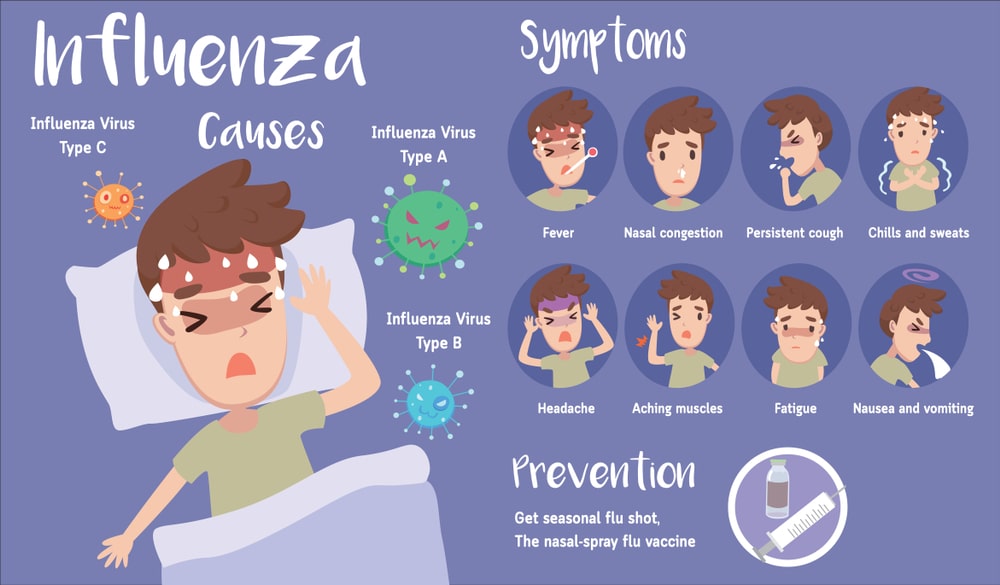Definition: “Influenza, an infectious illness caused by an influenza virus, is also known as Flu”. Flu is highly infectious (of a disease), transmitted from one person or organism to another, commonly regarded as a “contagious disease” through direct contact, and is generally spread by an infected person’s coughs and sneezes. While painful, the flu is rarely life-threatening. It happens globally and affects millions of people in all countries every year. By touching an infected human, for example, shaking hands, you may also catch influenza. Adults are infected 1-2 days before they show symptoms and up to 7 days after they become sick. This implies that before the individual comes to know that he or she is sick, the person may spread the influenza virus.
Types of Influenza
Table of Contents
It has three sub-types:
- Influenza A (Potentially serious disease, rapidly changing epidemics and pandemics).
- Influenza B (Less serious disease, more uniform epidemics, generally).
- Influenza C (Usually mild or asymptomatic, with limited effects on public health).
1. Influenza A and Influenza B: Influenza A and B viruses in the world are responsible for disease epidemics. Older people over 65 years of age and children below 18 months of age have the highest mortality rate.
2. Influenza C: The influenza virus type C is responsible for mild respiratory diseases and is not responsible for outbreaks.
Epidemiology
- Agent: Type A Type B, Type C Influenza.
- Host Characteristics: Age, Prior Exposure, Immune response.
- Intervention: Isolate, Treat, Immunize, Nutrition.
- Environment: Climate, Population (Overcrowding).
Agents/Factors
- Caused due to the presence of influenza viruses. These viruses are classified within the family orthomyxoviridae.
- Animals and birds such as; swine, dogs, cats, horses, wild birds, etc. are a reservoir of infection.
- The secretions present in the respiratory tract of influenza are infectious especially nasopharyngeal secretions.
Host Factor
- It occurs in all ages and among both sexes.
- It affects individuals over 65 years of age, children under 18 months of age, patients with diabetes, heart disease, kidney or respiratory disorders. Attack rates are lower among adults.
- High Care Fatality Ratio (CFR) during an epidemic in high-risk cases.
Environmental Factors
- Season: The seasonal occurrence is striking; in the northern hemisphere, epidemics typically occur in the winter months. In India, however, summer epidemics have sometimes occurred.
- Overcrowding: Overcrowding increases infection transmission. In closed population groups, the attack rates are high.
Mode of Transmission
1. Direct contact transmission: It requires close physical contact between the source of the disease and the transmission from person to person to a susceptible host. The intermediate object is not involved.
2. Indirect contact transmission: Indirect transmission of touch implies that the agent is transmitted by implies of a non-living entity.
3. Droplet Transmission: In mucus droplets that move a short distance (less than 1 meter), microbes are distributed.
4. Airborne Transmission: Airborne transmission refers to pathogens carried over a distance greater than 1 meter by water droplets or dust.
Symptoms of Influenza
- High fever
- Headache
- Runny or Stuffy Nose
- Sore throat
- Tiredness
- Coughing
- Vomiting
- Sneezing
- Muscle pain
Laboratory Diagnosis
- In diagnosing It, a variety of tests can help. Its diagnostic tests available include; viral culture, serology, rapid antigen scanning, polymerase chain reaction (RT-PCR) reverse transcription, immunofluorescence assays, and rapid molecular assays.
- Virus is detected by the indirect fluorescent antibody technique and by serological examination.
Specific diagnostic test:
- Nasopharyngeal swab.
- Nasal wash, aspirate swab.
- Broncho Alveolar Lavage [BAL].
- Oropharyngeal swab.
- Combined nasopharyngeal or nasal swab with an oropharyngeal swab.
Prevention and Control of Influenza
- Respiratory Hygiene: When coughing and sneezing, cover the nose/mouth with a handkerchief/tissue paper, use and dispose of tissues to absorb respiratory secretions.
- Hand Hygiene: After interaction with respiratory secretions and infected products, hand washing with non-antimicrobial soap and water, alcohol-based hand rub, or antiseptic handwashing.
- Avoid overcrowded places.
- Isolation.
- Use of Antiviral Drugs: Amantadine, Rimantidine, Zanamvir, Osletamivir, etc.
- Vaccines: Killed vaccine, live attenuated vaccines, and other vaccines like Recombinant vaccine.
Make sure you also check our other amazing Article on : Cholera
